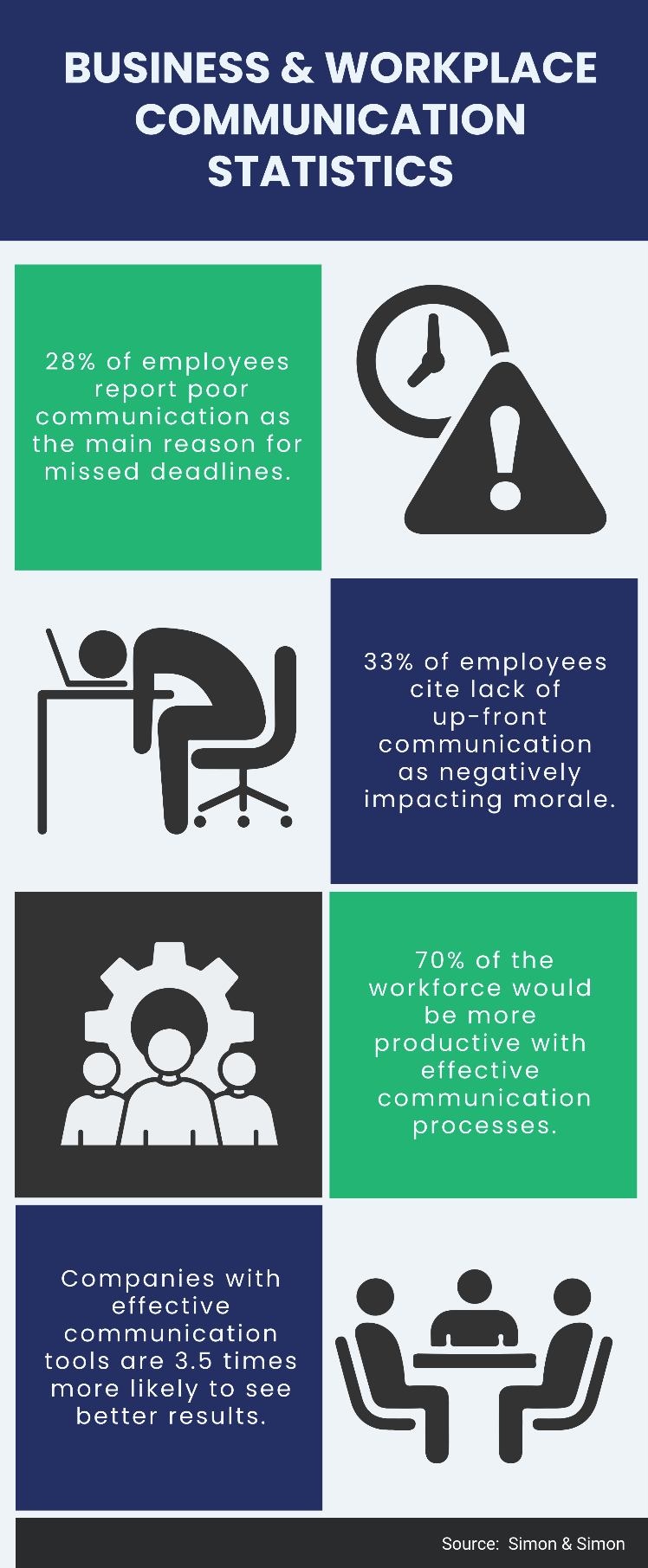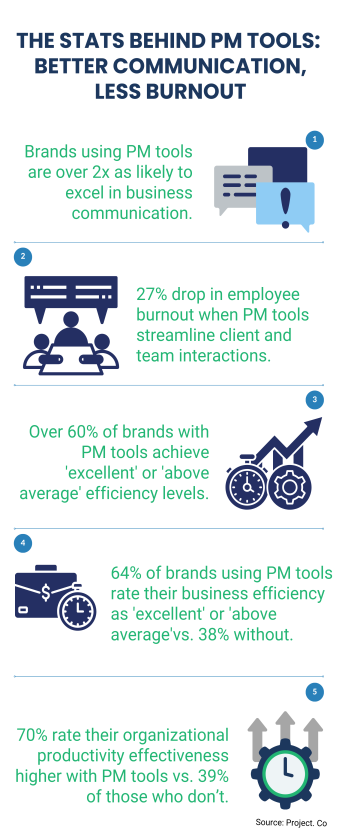

Have you ever wondered how many promising projects crumble under the weight of poor communication? For many leaders, the answer is 'far too many,' and the invisible costs are staggering.
Miscommunication can be the silent saboteur of success. It creates project delays and misalignment and increases risk, all while adding invisible costs that may not be immediately obvious but often accumulate in lost time, frustrated teams, and unmet goals. On the other hand, effective business communication is more than a skill—it's the strategic backbone of successful project management and business operations. It fuels collaboration, sharpens clarity, and aligns teams toward shared objectives. Yet, in today's multifaceted project environments, even the most experienced teams can falter if communication isn't managed effectively. Before diving into actionable strategies, it’s crucial to understand the key roadblocks to effective communication.

In fast-paced, complex environments, achieving seamless communication isn’t as simple as it sounds. Your communication strategy needs to be structured, and adaptive to drive performance and innovation. A communication framework rooted in proven tactics and data-driven solutions is key to staying ahead in an ever-evolving landscape.
This article explores eight actionable strategies for elevating business communication, from addressing common challenges to leveraging cutting-edge solutions like predictive project management to streamline communication and make them more insightful. By following these steps, you’ll build a communication culture that not only keeps projects afloat but propels them toward success.
To fully appreciate how communication drives project success, let’s explore its foundational role in project management.
Why Effective Business Communication is Essential in Project Management
As projects grow more complex and data-driven, relying solely on traditional communication methods is no longer sufficient. Predictive intelligence tools are emerging as game-changers, offering teams the foresight to navigate challenges before they arise. Integrating these tools can elevate communication from reactive to proactive, empowering teams to drive consistent success.
Effective business communication is the lifeline of any project. It’s not just about sharing information; it’s about ensuring that information is received, understood, and acted upon in a way that supports the project’s goals. Communication serves multiple purposes within a project setting.
Here’s why communication is indispensable in project management:
- Promotes Clarity and Understanding - Clear communication ensures that every team member understands the project’s goals, timelines, and roles. This eliminates ambiguity and reduces costly errors.
- Fosters Collaboration - Consistent and open communication helps build an environment where team members feel empowered and motivated to contribute their best.
- Supports Informed Decision-Making - The speed and accuracy of communication directly impact the quality of decisions made within a project. Teams that communicate well make quicker, more informed decisions that align with project goals.
- Builds Trust and Transparency - Transparency in communication builds trust among stakeholders, leading to smoother execution and more cohesive teams.
However, many organizations find communication challenging, particularly in complex or global project settings. Below, we address the key challenges that often hinder effective communication.
Common Challenges in Business Communication within Project Settings
 Despite its importance, many organizations encounter barriers that make business communication less effective. Understanding these common hurdles is the first step in overcoming them.
Despite its importance, many organizations encounter barriers that make business communication less effective. Understanding these common hurdles is the first step in overcoming them.
- Information Overload or Underload - Striking the right balance between information overload and underload remains a persistent challenge. Overflowing inboxes or endless notifications overwhelm team members, while insufficient updates lead to guesswork and misalignment.
- Fragmented Communication Channels - The absence of integration between tools often results in teams working in silos. This fragmentation creates delays as critical updates are scattered across platforms, diluting the efficiency of communication.
- Cultural and Linguistic Differences - In today’s global economy, teams often span multiple countries and languages. These differences can create communication barriers, misunderstandings, or misinterpretations, which can stall progress.
- Lack of Effective Feedback Mechanisms - Too often, communication is one-way. Without mechanisms for feedback, teams miss out on identifying pain points early, which can hinder continuous improvement and lead to deeper issues.
- Vague Roles and Responsibilities - When roles and responsibilities aren't clearly defined, communication suffers. Confusion about who is accountable for what leads to delays and friction within teams.
- Resistance to Change - Introducing new communication tools or methodologies can meet resistance from employees accustomed to older, more familiar ways. Without careful management, this can stall progress and prevent the adoption of more efficient systems.
By understanding these challenges, leaders can implement strategies that mitigate communication risks and drive better outcomes for their projects. Let’s dive into actionable strategies that can address these pain points and drive better project outcomes.
Eight Strategic Steps to Improve Business Communication
Improving business communication requires a proactive, well-rounded approach. Below are eight strategic steps designed to address common challenges and enhance communication in project settings.
1. Develop a Comprehensive Communication Plan
Every successful project starts with a robust communication plan. This isn't just a procedural document but a strategic asset that guides how information is shared across the project lifecycle.
- Define Key Stakeholders and Objectives - Identify who needs to be informed, what they need to know, and when they need to know it. Tailor your messaging to meet these specific needs.
- Establish Frequency and Channels - Determine the best communication channels and the frequency of updates. Whether it’s through weekly reports, daily standups, or real-time dashboards, consistency is key.
- Be Flexible - Projects evolve, and so must your communication plan. Stay agile, adjusting as needed to reflect changes in scope, team dynamics, or external pressures. For example, transitioning from static weekly reports to real-time dashboards can help address rapidly evolving stakeholder demands.
2. Standardize Communication Tools
One of the most straightforward ways to improve communication is to standardize the tools your team uses.
- Select Core Tools - Opt for a central platform for all communication. Make sure that everyone on your team is trained in using these tools.
- Reduce Silos - Having too many tools can fragment communication. Ensure seamless information flow across platforms to keep the entire team aligned.
3. Encourage Active Listening and Empathy
Communication isn’t just about speaking—it’s about listening. A culture of active listening fosters empathy and understanding, ensuring that communication is meaningful.
- Promote Empathetic Listening - Encourage your team to listen with the intent to understand, not just to reply. Empathy can bridge gaps, particularly in high-stress situations, leading to more effective teamwork.
- Address Misunderstandings Early - If communication breaks down or misunderstandings arise, resolve them swiftly before they become larger issues.
4. Create Regular Feedback Loops
Establishing regular feedback loops ensures that your communication is not just top-down but also bottom-up. This allows for continuous improvement.
- Weekly Check-ins - Consistent check-ins help ensure that all team members are aligned, and any issues are flagged early.
- 360-Degree Feedback - Use feedback loops that actively solicit input from every level of the organization. Whether through quick pulse surveys or detailed retrospectives, these mechanisms ensure that feedback drives continuous improvement.
 5. Train Teams in Cross-Cultural Communication
5. Train Teams in Cross-Cultural Communication
Cultural and linguistic differences can create hurdles in communication, especially for global teams.
- Invest in Cross-Cultural Training - Equip your teams with the knowledge and tools to navigate cultural differences in communication styles, decision-making, and conflict resolution.
- Facilitate Inclusive Communication - If necessary, use translation services or appoint cultural liaisons to ensure that messages are being interpreted as intended.
6. Use Visual Communication
Visual tools help break down complex information into more digestible formats. Incorporating visuals can vastly improve team understanding and engagement.
- Dashboards and Gantt Charts - These tools provide real-time visibility into project progress, enabling teams to see bottlenecks and adjust as necessary.
- Infographics - Use infographics to simplify complex data and communicate key points clearly. Visuals are particularly impactful in executive-level communication, where time is of the essence.
7. Clearly Define Roles and Responsibilities
Confusion over who is responsible for what can paralyze communication. The clearer the roles, the smoother the communication flow.
- RACI Matrix - A RACI (Responsible, Accountable, Consulted, Informed) matrix is an effective tool to clarify each team member’s responsibilities. It helps ensure that every task has clear ownership, preventing duplication of efforts and communication breakdowns. For example, ensuring that one individual is solely responsible for client-facing communication eliminates the confusion of duplicated efforts or mixed messages.
- Assign Accountability - Holding people accountable encourages clarity and transparency, leading to more effective communication.
8. Foster a Culture of Openness and Trust
Without trust, even the most well-intentioned communication strategies can fail. Building a culture of valuing transparency and openness will lead to more honest, effective communication.
- Create Psychological Safety - Encourage team members to voice concerns or ideas without fear of retribution. When people feel safe, they communicate more openly, leading to better problem-solving and innovation.
- Transparency in Reporting - Make project updates, risks, and progress visible to all stakeholders, fostering an environment of trust and reducing uncertainty.
Use Case - How Predictive Solutions Transform Business Communication
In a predominantly data-driven business landscape, traditional methods of business communication need to be complemented by more advanced, predictive approaches. This shift empowers organizations to preempt challenges and foster agility in project execution.
Predictive solutions leverage AI and machine learning to provide foresight into project challenges,
How Predictive Solutions Transform Communication
Predictive solutions utilize machine learning and AI to track project progress and provide data-driven insights that enhance communication and foster high-performance teams.
- Anticipating Challenges - Predictive analytics leverage historical data and machine learning to identify risks before they escalate. This empowers teams to prioritize risks, allocate resources efficiently, and communicate potential roadblocks to stakeholders effectively.
- Real-time Updates - Through automated dashboards and tailored notifications, predictive tools ensure all stakeholders receive timely, accurate updates. This minimizes miscommunication and keeps all stakeholders aligned with the project’s progress.
Practical Applications
For example, in a complex, multi-team project, predictive tools can flag potential resource constraints before they cause delays. This early detection enables project managers to reallocate resources proactively and communicate changes instantly, ensuring alignment across all teams.
Visual dashboards further enhance this process by displaying actionable insights in a user-friendly format, enabling faster and more informed decisions.
Elevating Business Communication with Predictive Intelligence
Effective business communication is not just a support function—it's the backbone of project success. By implementing the eight strategic steps discussed, organizations can create a communication culture that fosters collaboration, enhances clarity, and empowers teams to make informed decisions. Strong communication eliminates misalignment, ensures smoother execution, and builds trust across all stakeholders, creating a foundation for long-term business growth.
However, the next evolution in communication involves adopting predictive intelligence solutions like TrueProject. To truly future-proof communication, it's crucial to move beyond traditional methods and adopt predictive intelligence tools that enhance accuracy and timeliness. With its predictive intelligence capabilities, TrueProject reimagines communication by turning data into actionable insights, ensuring that every project decision is informed, proactive, and aligned with stakeholder expectations.
TrueProject offers a powerful, KPI-driven predictive intelligence solution that ensures nothing slips through the cracks. By continuously monitoring your project’s health in real-time, TrueProject provides up-to-date insights that empower you to address potential issues before they escalate. This level of proactive management guarantees that your stakeholders are always informed with the most accurate data, making communication not just seamless but foolproof.
TrueProject's real-time analytics help teams stay aligned with project goals, detect risks early, and maintain consistent communication across all stakeholders. With TrueProject, you can move from reactive to proactive communication, ensuring that your organization is always one step ahead, delivering successful outcomes every time. As businesses increasingly rely on data to drive decisions, TrueProject is the ultimate solution to streamline communication, boost project performance, and build a resilient, future-ready organization.
Ready to revolutionize your project communication? Explore TrueProject today and transform the way your teams collaborate, innovate, and succeed.
More information on TrueProject at trueprojectinsight.com

About the Author:
Nisha Antony is an accomplished senior marketing communications specialist at TrueProject and a leader in predictive intelligence. With over 16 years of experience, she has worked as a Senior Analyst at Xchanging, a UK consulting firm, and as an Internal Communications Manager on a major cloud project at TE Connectivity.
She is an insightful storyteller who creates engaging content on AI, machine learning, analytics, governance, project management, cloud platforms, workforce optimization, and leadership.
Endnotes
- Project Co Team. “Communication Statistics 2024.” Project Co - 2024. https -//www.project.co/communication-statistics/
- Simon & Simon Team. “20 Business & Workplace Communication Statistics [2024].” Simon & Simon - 2024. https -//www.simonandsimon.co.uk/blog/20-business-workplace-communication-statistics
- Duncan Lambden & Matt Reed. “The Importance of Effective Workplace Communication – Key Statistics for 2024.” Expert Market: July 1, 2024. https://www.expertmarket.com/phone-systems/workplace-communicationstatistics#:~:text=Here%20are%20the%20crucial%20statistics%20on%20workplace%20communication%3A,believe%20communication%20impacts%20their%20task%20efficacy%20every%20day





